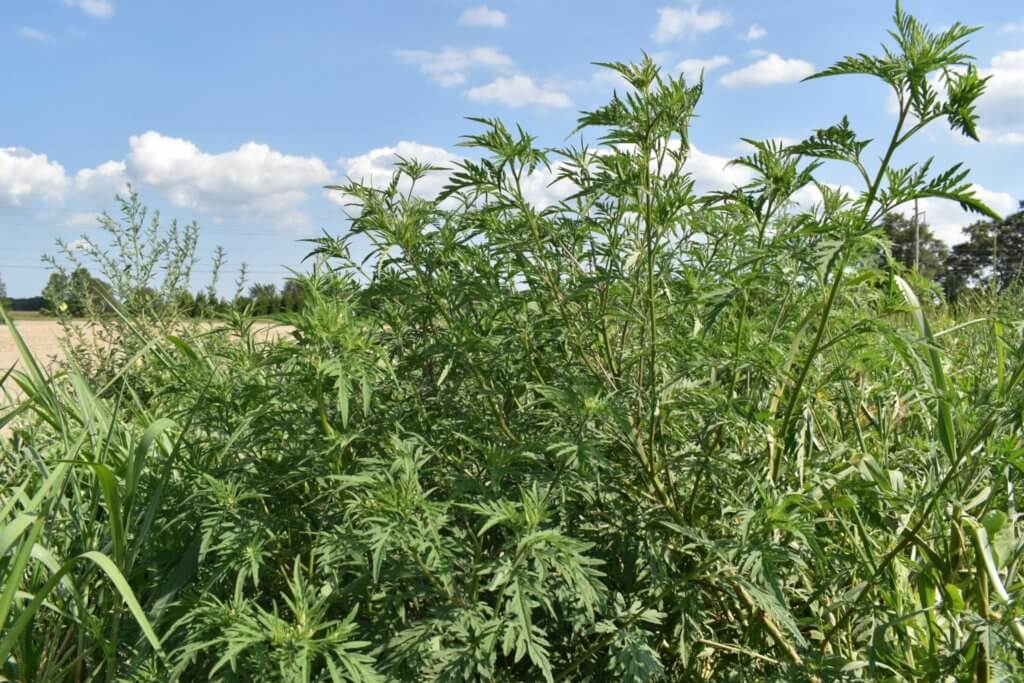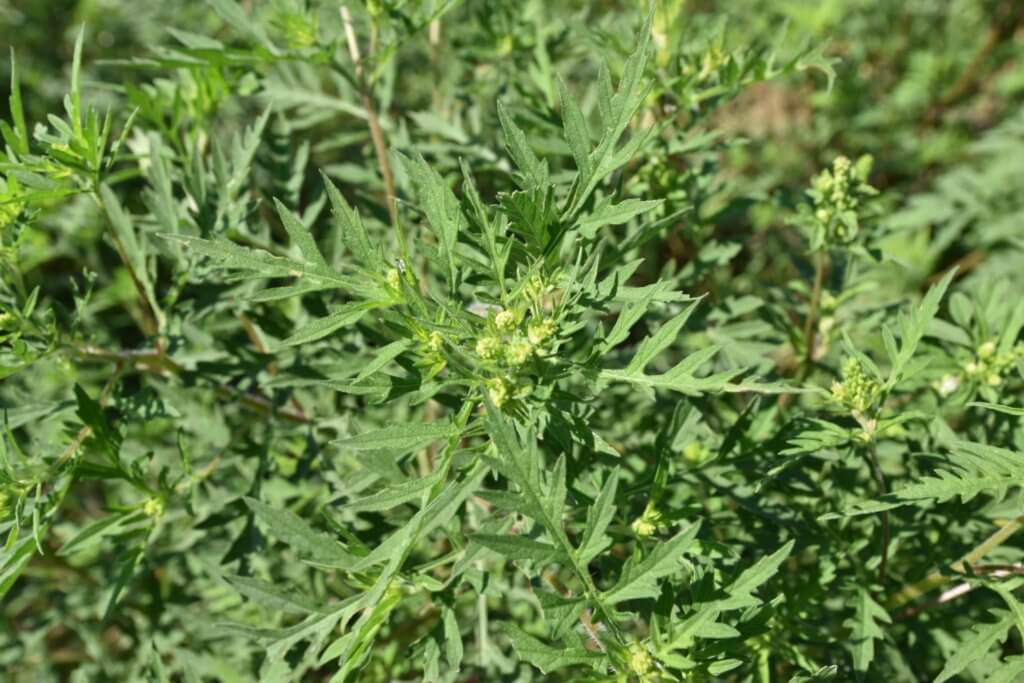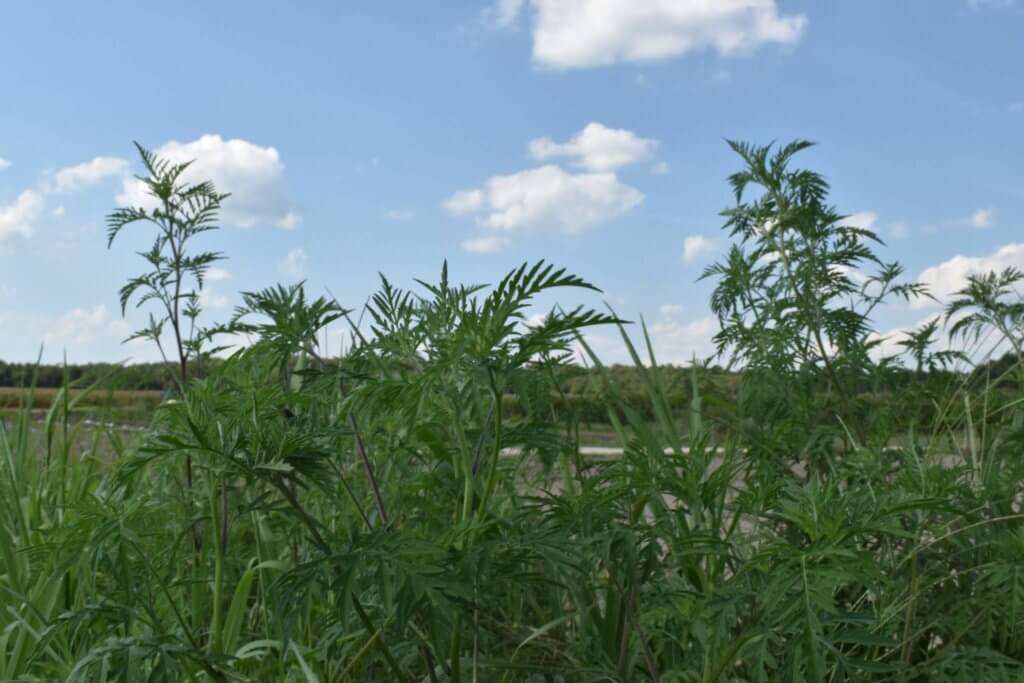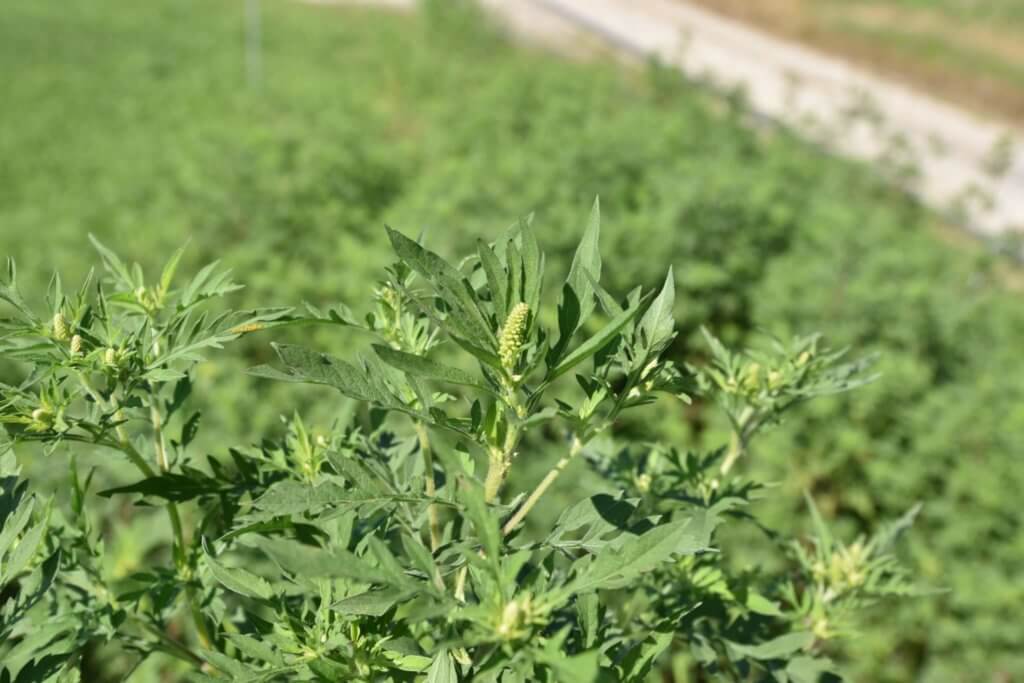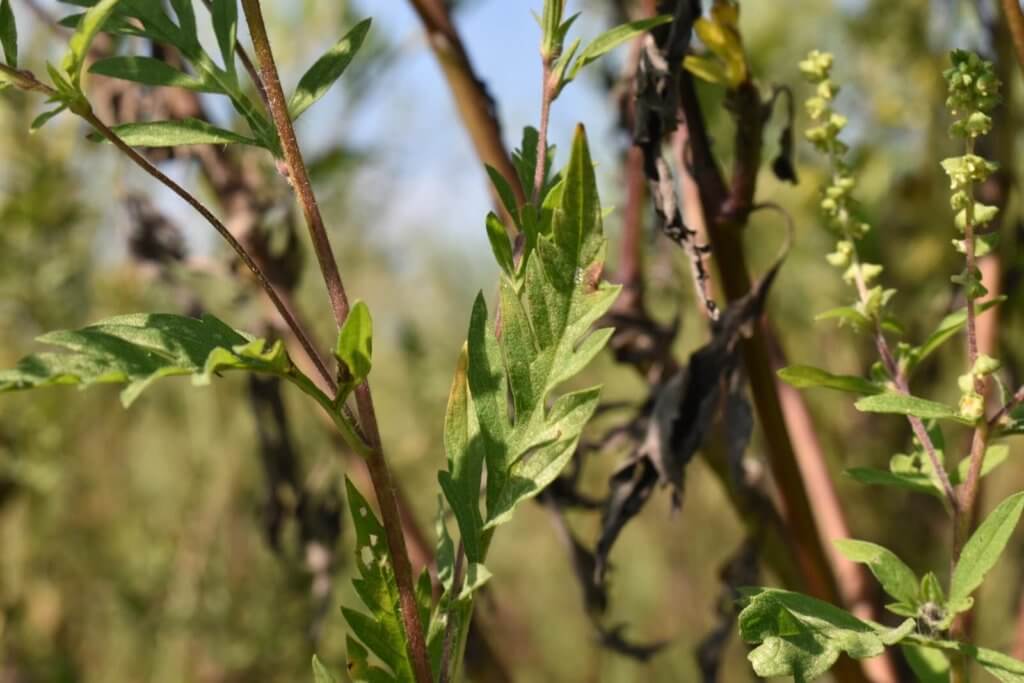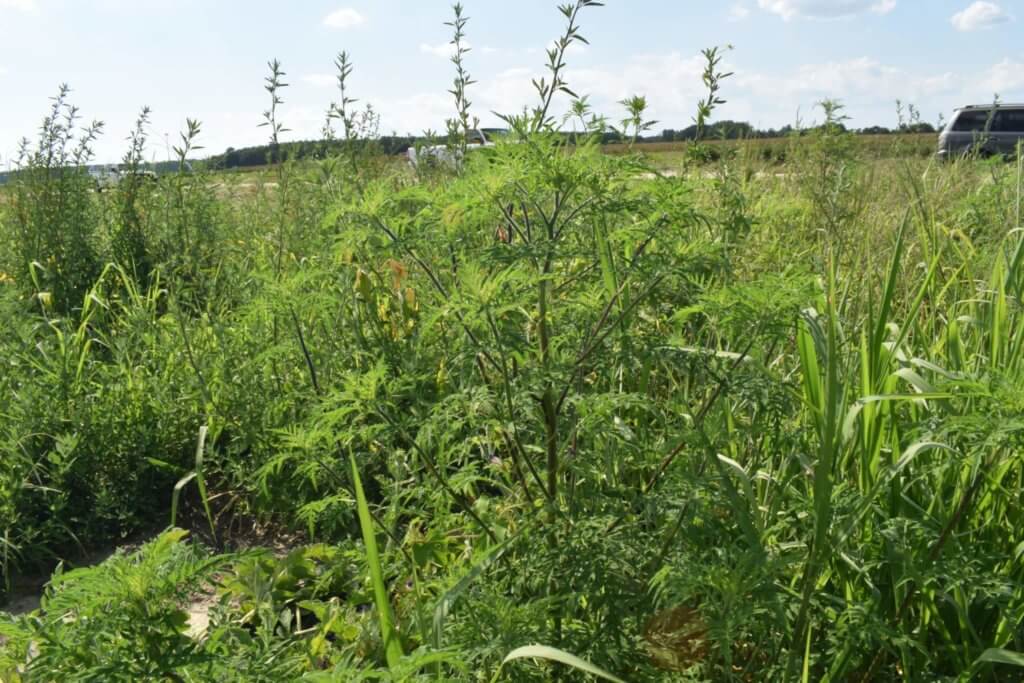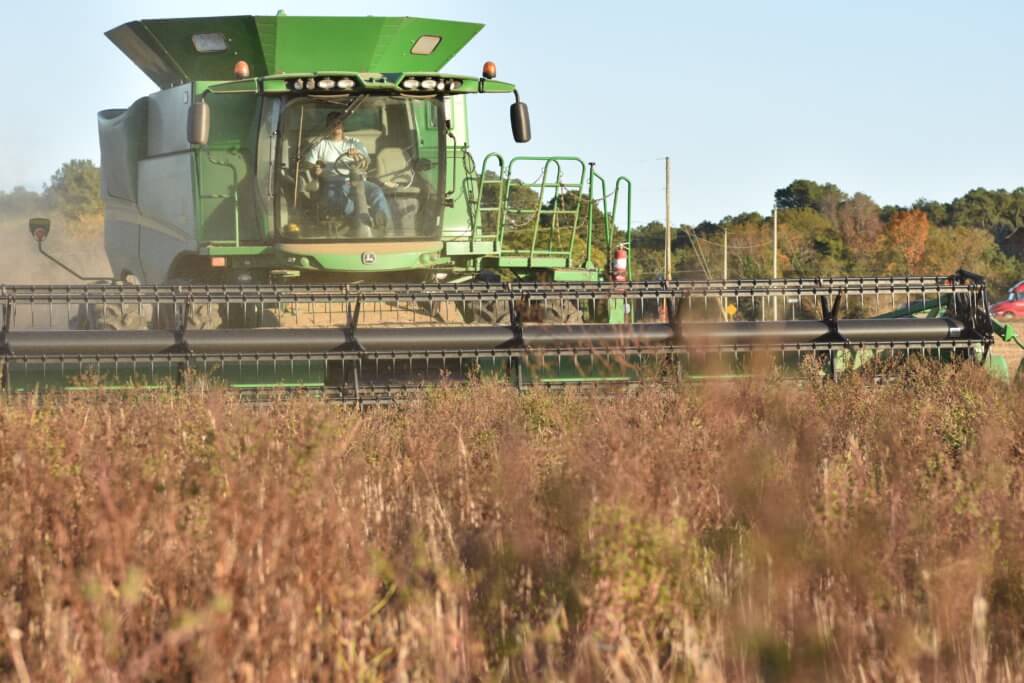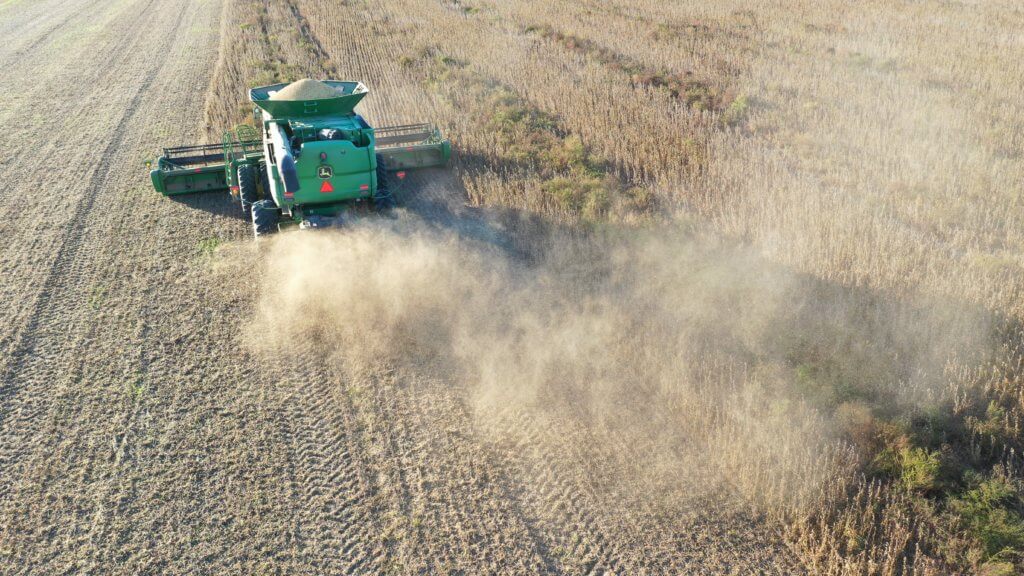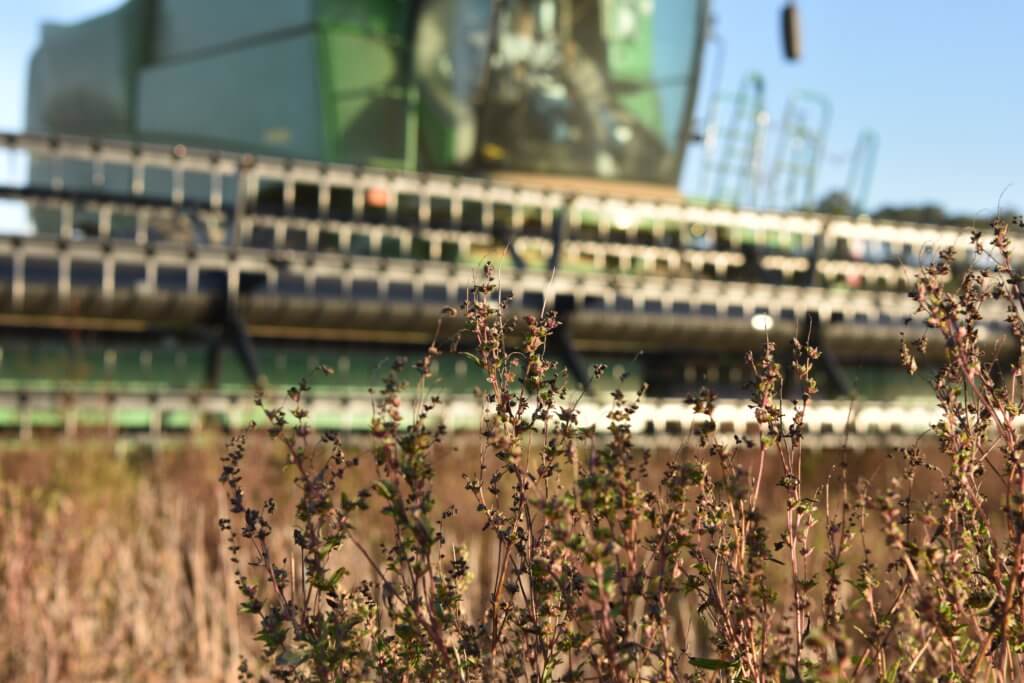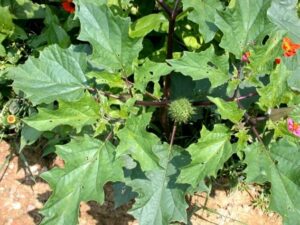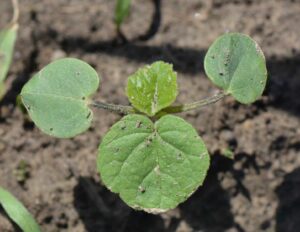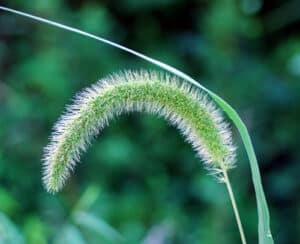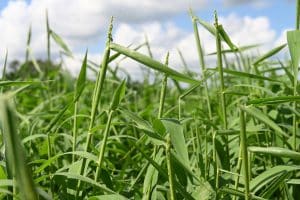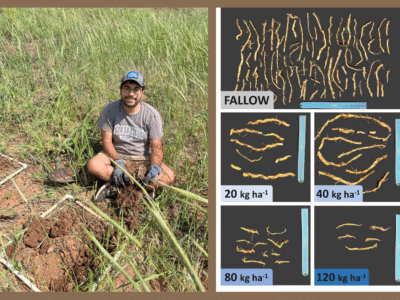Ambrosia artemisiifolia L.
Also known as: annual ragweed, burning bush, mock-cypress, Mexican firebush, Mexican fireweed
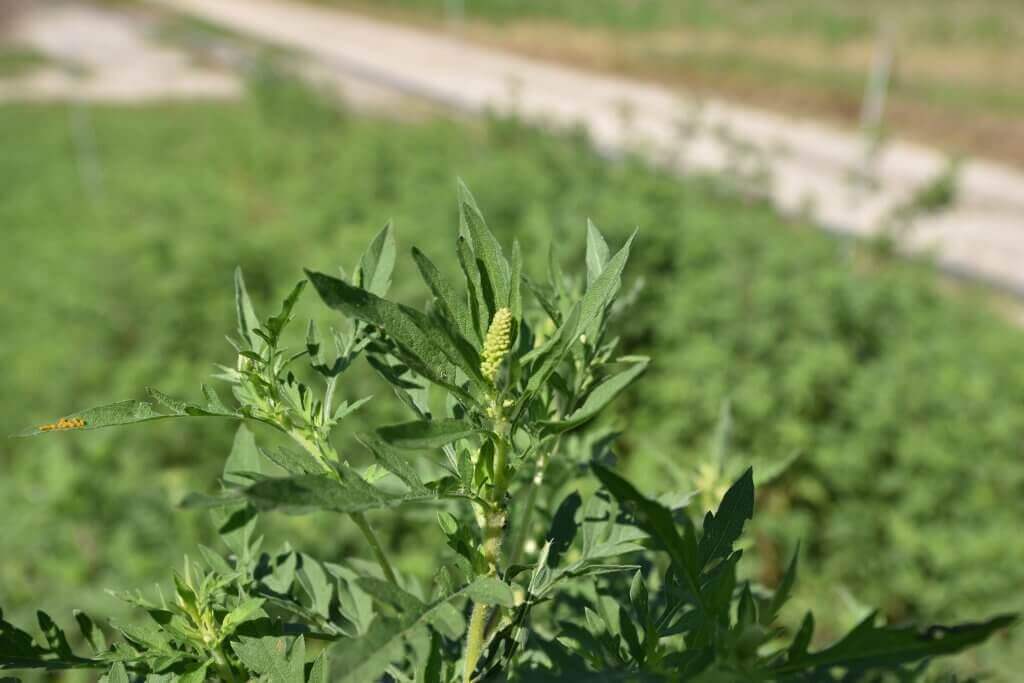
Biology
Common ragweed tolerates a wide range of environmental conditions which allows it to be a weed in a variety of cropping systems. The weed has many ecotypes which vary in branching and growth. Furthermore, the propensity of the weed to colonize non-cropped areas, such as roadsides, means long-term management can be challenging due to the ease of reinfestation. However, common ragweed requires light to germinate, which creates several opportunities for management including burying the seeds via tillage, and the use of stale seedbeds.
Where is common ragweed a problem?
Common ragweed is native to North America and is found in agricultural fields, roadsides, vacant lots, and fallow areas. It is most prevalent in reduced-till and no-till systems with undisturbed seedbeds. However, the weed can also successfully establish in various tillage systems and at various fertility levels. Common ragweed can thrive in extreme environments where other weeds would not survive, such as saline roadsides. Studies of common ragweed show that the weed grows best in a warm, moist environment rather than in dry, well-drained soils.
What is the emergence pattern of common ragweed?
It is classified as a summer annual and is one of the first summer annual species to emerge in the spring (beginning in March in the Mid-Atlantic region). Common ragweed requires a cold dormant period in order for seed to germinate. While warm temperatures are necessary for germination, common ragweed seeds will become dormant again if air temperatures rise above 90℉. Common ragweed needs light to germinate and so it must be at or near the soil surface, or exposed to light during tillage, to germinate. Seeds buried deeper than 2 inches will not germinate unless the seedbank is disturbed with tillage. Common ragweed has a relatively short emergence period, with emergence of each cohort declining rapidly by early June. Even temporary drought conditions, which are often seen at the surface of tilled fields in early spring, will not deter its growth. Once emerged, the weed grows quickly during its juvenile phase. Common ragweed that emerges before or with the cash crop, can pose a significant threat to the growth and yield of the cash crop, this is especially true for soybeans, as corn grows taller.
What is the lifecycle of common ragweed?
After emerging early in the spring, common ragweed grows quickly – up to six feet tall in optimal conditions. The growth of common ragweed is highly dependent on its environment, which includes population density, temperature, moisture, and even latitude. Population density affects the height of the plant and the amount of branches it develops. A greater population density will result in taller plants and the fewer side branches. Latitude impacts the growth and flowering of common ragweed. Ecotypes found in lower latitudes have a longer growing season so they grow larger and flower as late as September. The higher latitude ecotypes are generally much smaller and flower earlier in the summer. Flowering time also affects the number of seeds the weed is capable of producing: studies have shown that larger plants produce more seed.
Common ragweed begins to flower when days begin to shorten, regardless of plant height. Flowering begins after the summer solstice, once there is at least an eight hour period of darkness. Under optimal conditions, the plant flowers for 30 days, and requires another 50 days for the seeds to mature.
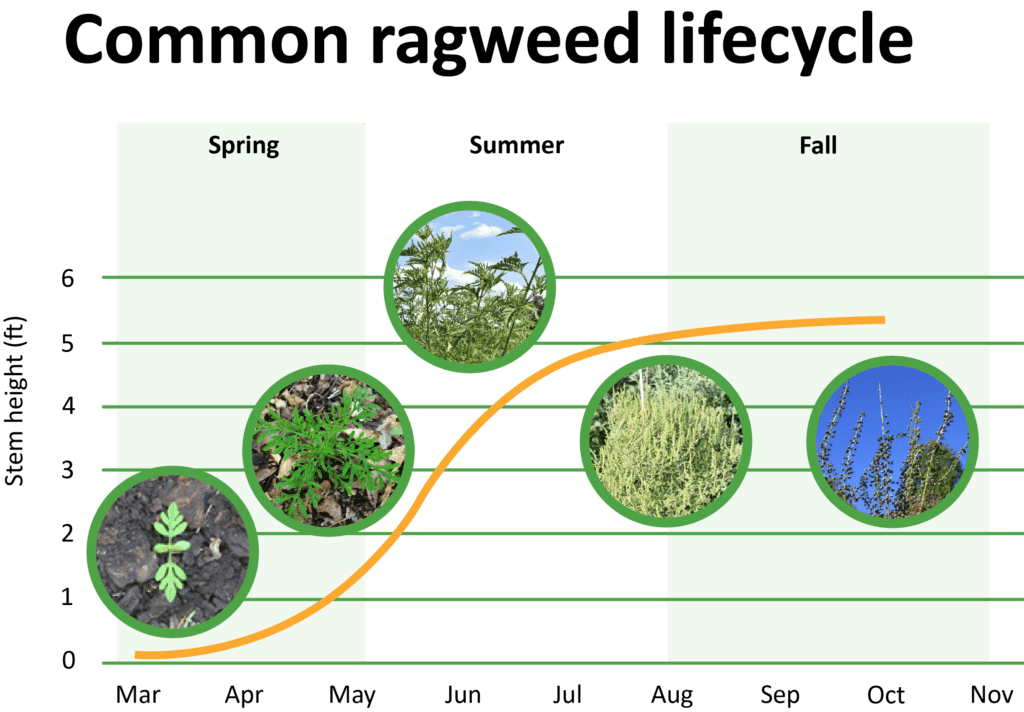
How does common ragweed spread?
Studies show that common ragweed seeds spread quickly through several means including: water, birds, contaminated seed, farm equipment, roads, and burrowing animals. Farm equipment can spread seeds from a contaminated field to a non-contaminated field. All agricultural vehicles should be thoroughly cleaned after operating in infested fields. A study conducted in Quebec concluded that the common ragweed population initially expanded along riverbanks; however, the creation of a road system supported a rapid, vast expansion in the weed’s range. Roadsides are a safe haven for common ragweed because the weed quickly dominates vacant land. Even if best management practices are followed in agricultural fields, it is difficult to completely eradicate common ragweed because field edges and roadsides provide a refuge for later reinfestation.

How many seeds can common ragweed produce and how long can those seeds survive?
Plants that grow for the entire season can produce up to 62,000 seeds. The seed production of common ragweed is dependent on the size of the plant. Plants that emerge early and flower later in the season are much larger and produce significantly more seed. While other factors affect biomass production, early-emerging plants can produce up to six times the amount of biomass and seeds as plants that emerge later in the season. Controlling common ragweed early in the season is essential for reducing weed seed production.
Common ragweed seeds near the soil surface will only survive a few years with 50% of the seeds losing viability in less than a year; however, seeds buried deeper can remain viable in the seedbank for up to 30 years. Seedbank longevity makes reducing common ragweed seed production critical for long-term management.
What other biological weaknesses does common ragweed have that can be targeted with management techniques?
The most vulnerable point in the life cycle of common ragweed is the seed. Common ragweed requires sunlight to both emerge and establish successfully. Burying common ragweed deeper than two inches obstructs its access to light and inhibits germination. Tillage can bury the seeds deeply enough that they will not emerge; however, this can unearth previously buried seed, as well. Practices that shade the soil such as cover cropping or narrow row spacing can suppress weed seed germination and reduce seedling growth.
Herbicide Resistance
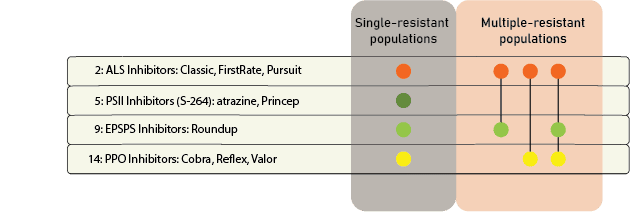
Contact your local extension office for details about resistance in your area and management options.
*Herbicide names listed are not the only products that contain these specific active ingredients. Please check herbicide labels for more information. Last updated on: 6-29-2020

Integrated Weed Management Strategies
Cultural Tactics: Planting date is a cultural tactic which can reduce common ragweed populations. Since common ragweed is an early emerging species, it is advisable to plant later in the spring after many of the plants have emerged and can be controlled with tillage or herbicides. Double cropping soybeans after wheat ensures that most of the common ragweed seeds near the soil surface have germinated and produced seedlings and can be controlled by the time soybeans are planted.
Crop rotation helps manage common ragweed infestations. Including corn in the rotation helps because its height makes it an aggressive competitor and there are several effective herbicide options for use in corn. As previously noted, later planted summer crops can enhance control. Planting winter wheat before double crop soybeans also suppresses common ragweed germination by shading the soil.
Other practices that shade the soil will also improve control since light is critical for both germination and establishment of common ragweed. Narrow-row soybeans (less than 20-inch row) close canopy faster than wide-row soybeans. If planting double crop soybeans, narrow rows can both increase yield and suppress common ragweed populations. Higher crop seeding rates can also increase common ragweed suppression.
Cover Crops: A high-residue cover crop, such as fall-planted cereal rye, can compete with and shade emerging seedlings. Best results occur when the rye cover crop is terminated within 7 to 10 days prior to planting. This maximizes cover crop biomass and increases shade. Rolled-Rye, however, is not an effective control for common ragweed in soybean because the ragweed emerges before the rye is rolled and the roller crimper does not kill the ragweed. The ragweed will often find a gap in the rolled rye, grow through it, and compete with the soybeans. An alternative method of cover crop termination is preferred when cover cropping with rye.
In northern regions of the US where double-cropping after winter cereal is not an option, interseeding red clover can suppress common ragweed seed emergence in the spring. Red clover seed can be broadcasted into existing winter wheat in the late winter, creating an understory of cover crop which does not decrease wheat yields. A study conducted in Michigan found that common ragweed biomass decreased significantly – by up to 50% – when red clover was frost seeded into winter wheat.
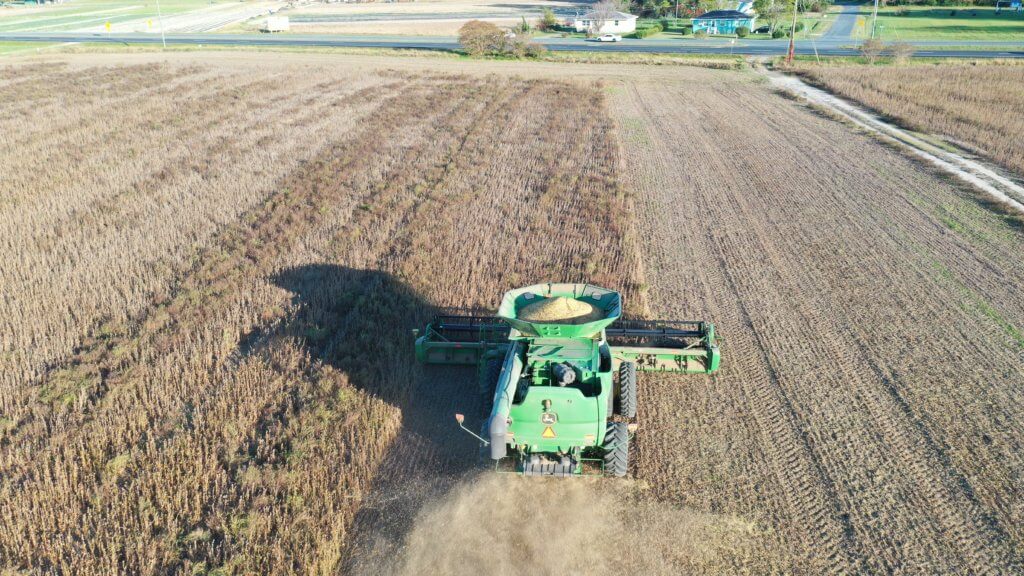
Mechanical: Aggressive tilling tactics such as moldboard plowing or inversion tillage are an effective method of controlling common ragweed because seeds will not germinate when buried deep under the soil surface. However, shallow tilling, such as discing, chisel plowing, or rota-tilling can also disturb the seedbank and bring previously dormant seeds back to the soil surface. Common ragweed has the unique ability to adapt to recently disturbed environments and can dominate recently cleared fields. Therefore, the timing of tillage operations is very important in managing common ragweed. Aggressive tillage is most effective in late spring prior to planting. This allows the crop to be planted into weed-free conditions. Tilling at night can reduce seed germination. Tillage after planting may control late flushes of weeds. Inter-row cultivation and blind tillage may be used to control weeds growing at the early stages of row crops.
Mowing nearby roadsides could also decrease the prevalence of common ragweed. A study conducted in Quebec regarding the spread of common ragweed concluded that controlling the weed in agricultural fields alone will not stop it from spreading. Mowing nearby roadsides several times a year could reduce reinfestation of agricultural fields, as common ragweed is not tolerant to mowing.
Chemical: An effective common ragweed herbicide program should provide consistent control, minimize interference with crops early in the season, minimize herbicide resistance, and reduce the seedbank. Combining preplant, preemergence, and postemergence herbicide applications and including at least two effective herbicide sites of action is essential to creating an effective common ragweed control herbicide plan.
Effective programs begin by controlling ragweed prior to cash crop emergence with a preplant herbicide (or with tillage). It is important for the crop to have at least four weeks of weed-free conditions. Keep the field weed-free by applying preemergence and postemergence herbicides. Apply postemergence herbicides before weeds exceed 4 inches in height. Examples of herbicides for use in corn include: atrazine (Aatrex), dicamba, 2,4-D, clopyralid, halosulfuron (Permit), and glyphosate (Roundup). Examples of herbicides for use in soybean include: metribuzin (Sencor), cloransulam (FirstRate), flumioxazin (Valor XLT), lactofen (Cobra), fomesafen (Reflex), glufosinate (Liberty), and glyphosate (Roundup). Examples of herbicides for cotton include flumioxazin, fomesafen, fluometuron (Cotoran), and trifloxysulfuron (Envoke). Refer to herbicide labels for rates and use in your area.
Biological: Several forms of biological control of common ragweed have been tested, although none are in widespread use. Ground beetles eat common ragweed seeds on or near the surface. Zygogramma suturalis, commonly known as the ragweed leaf beetle, has been introduced in Russia and China to control common ragweed populations. Scientists in Europe have tested the use of several fungi as biological control agents. While common ragweed has some naturally occuring predators in North America, none of these biological agents are commercially available.
Similar Weed Species
Giant ragweed is one of the first summer annuals to emerge, with several flushes throughout the growing season. The weed is very competitive and can significantly reduce soybean and corn yield. Read more on our giant ragweed page.
Mugwort, Artemisia vulgaris, resembles common ragweed. Mugwort is a perennial native to Eurasia, although it is now prevalent throughout North America. Mugwort has deeply lobed leaves and an alternating leaf pattern similar to that of common ragweed; however, the underside of the mugwort leaves have matted, whitish-gray hairs.
Author
- Aida Bagheri
Editors
- Victoria Ackroyd
- Michael Flessner
- Steven Mirsky
- Claudio Rubione
- Mark VanGessel
Reviewed by
- Michael Marshall, Clemson University
- Bryan Brown, New York State Integrated Pest Management
Resources
Jordan T, Nice G, Smeda R, Sprague C, Loux M, Johnson B (n.d.) Biology and Management of Common Ragweed. https://weedscience.missouri.edu/publications/gwc-14.pdf Accessed: March 25, 2020
Take Action: Common Ragweed: https://growiwm.org/factsheets/common-ragweed-management-in-soybeans/.Accessed: July 15, 2020
Bradley K, Hagood E (2020) Identification and control of mugwort (Artemisia vulgaris L.) in Virginia. https://vtechworks.lib.vt.edu/server/api/core/bitstreams/673ab0dc-a899-4686-8455-41a1108ab84c/content. Accessed: June 3, 2020
Citations
Armesto J, Pickett S (1985) Experiments on disturbance in old-field plant communities: impact on species richness and abundance. Ecology 66:230-240. doi.org/10.2307/1941323
Bazzaz F (1974) Ecophysiology of Ambrosia artemisiifolia: a successional dominant. Ecology 55:112-119 doi.org/10.2307/1934623
Brandes D, Nitzsche J (2006) Biology, introduction, dispersal, and distribution of common ragweed (Ambrosia artemisiifolia L.) with special regard to Germany. Nachrichtenblatt des Deutschen Pflanzenschutzdienstes 58:286-291. doi.org/10.24355/dbbs.084-200611290100-17
Chikoye D, Weise S, Swanton C (1995) Influence of common ragweed (Ambrosia artemisiifolia) time of emergence and density on white bean (Phaseolus vulgaris). Weed Science 43:375-380. doi.org/10.1017/S0043174500081352
Coble H, Williams F, Ritter R (1981) Common ragweed (Ambrosia artemisiifolia) interference in soybeans (Glycine max). Weed Science 29:339-342. doi.org/10.1017/S0043174500062081
Deen W, Hunt L, Swanton CJ (1998) Photothermal time describes common ragweed (Ambrosia artemisiifolia L.) phenological development and growth. Weed Science 46:561-568. doi.org/10.1017/S0043174500091104
Deen W, Hunt T, Swanton CJ (1998) Influence of temperature, photoperiod, and irradiance on the phenological development of common ragweed (Ambrosia artemisiifolia). Weed Science 46:555-560. doi.org/10.1017/S0043174500091098
Dickerson CT, Sweet RD (1971) Common ragweed ecotypes. Weed Science 19:64-66. doi.org/10.1017/S0043174500048281
DiTommaso A (2004) Germination behavior of common ragweed (Ambrosia artemisiifolia) populations across a range of salinities. Weed Science 52:1002-1009. doi.org/10.1614/WS-04-030R1
Gentili R, Ambrosini R, Montagnani C, Caronni S, Citterio S (2018) Effect of soil pH on the growth, reproductive investment and pollen allergenicity of Ambrosia artemisiifolia L. Front Plant Science 9:13-35. doi.org/10.3389/fpls.2018.01335
Gerber E, Schaffner U, Gassmann A, Hinz H, Seier H, Muller-Scharer H (2011) Prospects for biological control of Ambrosia artemisiifolia in Europe: learning from the past. Weed Research 51:559-573. doi.org/10.1111/j.1365-3180.2011.00879.x
Lavoie C, Jodoin Y, Merlis AG De (2007) How did common ragweed (Ambrosia artemisiifolia L.) spread in Québec? A historical analysis using herbarium records. Journal of Biogeography 34:1751-1761. doi.org/10.1111/j.1365-2699.2007.01730.x
Martin M, Olsen M, Samaniego J, Zimmer E, Gilbert E (2016) The population genomic basis of geographic differentiation in North American common ragweed (Ambrosia artemisiifolia L.). Ecology and Evolution 6:3760-3771. doi.org/10.1002/ece3.2143
Martin M, Zimmer E, Olsen M, Foote A, Gilbert M, Brush E (2014) Herbarium specimens reveal a historical shift in phylogeographic structure of common ragweed during native range disturbance. Molecular Ecology 23:1701-1716. doi.org/10.1111/mec.12675
Mitich L (1996) Ragweeds (Ambrosia spp.)—The hay fever weeds. Weed Technology 10:236-240. doi.org/10.1017/S0890037X00045966
Mutch D, Martin T, Kosola K (2003) Red clover (Trifolium pratense) suppression of common ragweed (Ambrosia artemisiifolia) in winter wheat (Triticum aestivum). Weed Technology 17:181-185. doi.org/10.1614/0890-037X(2003)017[0181:RCTPSO]2.0.CO;2
Oswalt ML, Marshall GD (2008) Ragweed as an example of worldwide allergen expansion. Allergy, Asthma & Clinical Immunology 4:130-135. doi.org/10.1186/1710-1492-4-3-130
Patracchini C, Vidotto F, Ferrero A (2011) Common ragweed (Ambrosia artemisiifolia) growth as affected by plant density and clipping. Weed Technology 25:268-276. doi.org/10.1614/WT-D-09-00070.1
Shrestha A, Roman E, Thomas A, Swanton CJ (1999) Modeling germination and shoot-radicle elongation of Ambrosia artemisiifolia. Weed Science 47:557-562. doi.org/10.1017/S0043174500092262
